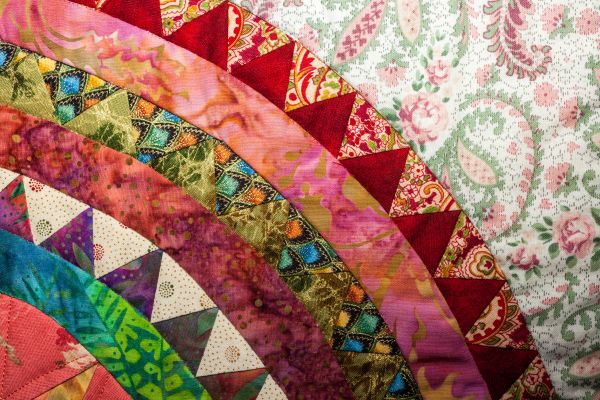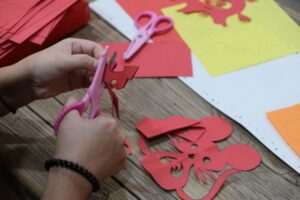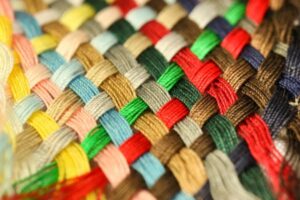Quilting holds a cherished place in American history, reflecting the country’s diverse cultural heritage and the resilience of its people. What began as a practical means of creating warmth and preserving resources evolved into a vibrant art form celebrated for its intricate designs, storytelling, and community-building. In this article, we will delve into the rich history of quilting in America, exploring its origins, cultural significance, and its transformation into a cherished expression of creativity and craftsmanship.
1: Colonial Quilts: From Necessity to Tradition
1.1 Practicality and Resourcefulness: Early Quilts in Colonial America
During colonial times, quilts served a practical purpose of providing warmth and comfort. Early American settlers used their resourcefulness to repurpose fabric scraps and create simple quilts using basic techniques such as patchwork and utilitarian stitching.
1.2 Cultural Influences: Quilting Traditions from Europe and Africa
The quilting traditions brought by European immigrants and the influence of African textiles and patterns played a significant role in shaping colonial quilts. European techniques introduced complex block patterns and decorative stitching, while African textiles inspired vibrant colors and improvisational designs.
1.3 Quilts as Historical Artifacts: Uncovering Stories of Early America
Colonial quilts provide valuable insights into the lives and cultural identities of early Americans. Many quilts were meticulously crafted with symbolic motifs, personal messages, and family crests, serving as historical artifacts that document the social fabric and aspirations of the time.
2: Quilting on the Frontier: Stitching Communities Together
2.1 Quilting Bees: Social Gatherings on the Frontier
As America expanded westward, quilting bees became integral to community life. Women would come together to quilt, share stories, and support one another. These gatherings fostered a sense of camaraderie, provided a creative outlet, and strengthened social bonds in the face of the challenges of pioneer life.
2.2 Prairie Quilts: Beauty in Simplicity
Prairie quilts emerged as a distinct style during the westward expansion. These quilts, characterized by their simple geometric patterns and earthy color palettes, mirrored the vast landscapes of the Midwest and showcased the creativity and resourcefulness of women on the frontier.
2.3 Quilts on the Oregon Trail: Treasured Keepsakes of a Journey
Quilts played a significant role in the lives of pioneers traveling the Oregon Trail. They provided warmth during arduous journeys, served as familiar reminders of home, and became cherished heirlooms passed down through generations, carrying stories of resilience and adventure.
3: Civil War Quilts: Stitching History in Turbulent Times
3.1 Quilting for a Cause: Patriotism and Activism
During the Civil War, quilting took on new significance as women rallied together to support the war effort. Quilt auctions and fairs raised funds for soldiers, while quilts were made and donated to provide comfort and warmth to soldiers on the front lines.
3.2 Album Quilts: Stitching Stories of a Nation Divided
Album quilts gained popularity during the Civil War, with women using them as a means of expressing patriotism, documenting personal stories, and commemorating loved ones. These intricate quilts featured embroidered names, patriotic symbols, and appliquéd imagery representing the hopes and struggles of the era.
3.3 Quilts as Historical Testaments: Preserving the Legacy of the Civil War
Civil War quilts have become valuable historical artifacts, offering a glimpse into the lived experiences of individuals during this tumultuous period. They bear witness to the resilience and creativity of women during times of war and serve as poignant reminders of the human stories behind historical events.
4: The Quilt Revival: Honoring Tradition in Modern Times
4.1 The Quilt Revival Movement: A Resurgence of Interest
In the mid-20th century, there was a resurgence of interest in quilting, known as the quilt revival movement. This movement focused on honoring traditional quilt-making techniques, preserving cultural heritage, and celebrating the artistry and craftsmanship of quilts.
4.2 Quilt Guilds: Fostering Creativity and Community
Quilt guilds emerged as hubs for quilters to connect, learn, and share their passion. These communities offered workshops, exhibitions, and mentorship opportunities, creating spaces where quilters could expand their skills, showcase their work, and find inspiration from fellow enthusiasts.
4.3 Quilting as an Art Form: Pushing Boundaries and Exploring Creativity
Quilters began to push the boundaries of traditional quilt-making, embracing innovative techniques, non-traditional materials, and contemporary design principles. Quilts transformed into expressions of personal narratives, abstract art, and social commentary, blurring the lines between quilting and other visual art forms.
5: Amish Quilts: Tradition, Simplicity, and Precision
5.1 Amish Quilting Traditions: Preserving Ancestral Techniques
Amish quilting traditions are deeply rooted in the principles of simplicity, functionality, and community. Quilters within Amish communities have passed down techniques such as hand piecing, hand quilting, and intricate geometric designs for generations, keeping their cultural heritage alive.
5.2 The Beauty of Solid Colors: Amish Quilt Aesthetics
Amish quilts are renowned for their use of solid colors and striking geometric patterns. By limiting the color palette to rich, solid hues, these quilts emphasize the intricate piecing and quilting techniques, creating a visually striking and harmonious composition.
5.3 Amish Quilts as Family Heirlooms: The Legacy of Craftsmanship
Amish quilts hold great significance as treasured family heirlooms. Passed down from one generation to another, these quilts embody the history, love, and dedication of the quilters who created them. They serve as tangible reminders of family connections, cultural heritage, and the enduring beauty of handmade craftsmanship.
6: African American Quilting: Cultural Resilience and Artistic Expression
6.1 The African American Quilting Tradition: A Legacy of Resilience
African American quilting traditions are deeply rooted in the experiences of enslaved individuals and their descendants. Quilts became symbols of resilience, storytelling, and cultural preservation, allowing African Americans to express their creativity, resist oppression, and assert their identity.
6.2 The Underground Railroad Quilts: Secret Messages and Freedom
During the era of slavery, African American quilters used their craft to communicate coded messages and aid escaping slaves on the Underground Railroad. Quilts with specific patterns and colors were strategically displayed to indicate safe houses, escape routes, and warnings of danger, serving as powerful symbols of hope and liberation.
6.3 African American Quilting Aesthetics: Color, Improvisation, and Tradition
African American quilts are characterized by vibrant colors, improvisational designs, and a strong connection to African textile traditions. Quilters draw inspiration from their African roots, incorporating elements such as strip-piecing, appliqué, and bold geometric patterns, creating quilts that celebrate cultural identity and artistic expression.
7: Contemporary Quilting: Innovations and Boundless Creativity
7.1 Art Quilts: Exploring New Frontiers
Contemporary quilting has embraced the realm of fine art, blurring the boundaries between quilting and other visual art forms. Art quilts push the boundaries of traditional techniques, utilizing a range of materials, mixed media, and experimental processes to create expressive, thought-provoking, and visually stunning pieces.
7.2 Quilting in the Digital Age: Technology and Creativity
Advancements in technology have revolutionized the quilting process, opening up new possibilities for design, pattern creation, and collaboration. Quilters now have access to digital tools, design software, and online communities that foster creativity, inspire innovation, and provide platforms for sharing and learning.
7.3 Quilting for Social Change: Activism and Community Engagement
Contemporary quilters are using their craft to address social issues, raise awareness, and promote positive change. Quilt-making projects focused on themes such as diversity, inclusion, environmental sustainability, and social justice serve as powerful tools for storytelling, education, and community engagement.
8: Quilt Patterns: Tradition and Innovation
8.1 Traditional Quilt Patterns: Echoes of the Past
Quilt patterns such as the Log Cabin, Double Wedding Ring, and Lone Star have become iconic symbols of quilting tradition. These patterns have been handed down through generations, representing the history, stories, and cultural significance of quilting.
8.2 Modern Quilt Patterns: Pushing the Boundaries
In addition to traditional patterns, modern quilt designers have introduced innovative and contemporary designs. Bold geometric shapes, abstract compositions, and asymmetrical layouts are some of the elements that define modern quilt patterns, showcasing the ever-evolving nature of the craft.
9: Quilting Communities: Sharing, Learning, and Inspiring
9.1 Quilt Guilds and Associations: Fostering Collaboration and Education
Quilt guilds and associations provide valuable resources and opportunities for quilters to come together, share their knowledge, learn new techniques, and collaborate on projects. These communities play a vital role in preserving quilting traditions, supporting emerging artists, and inspiring creativity.
9.2 Quilting Retreats and Workshops: Immersion in the Craft
Quilting retreats and workshops offer immersive experiences for quilters of all levels. These events provide a nurturing environment where participants can enhance their skills, explore new techniques, and connect with fellow enthusiasts, fostering a sense of camaraderie and personal growth.
10: Quilting as a Personal Journey: Creativity and Self-Expression
10.1 Quilting as Therapeutic: The Healing Power of Creativity
For many individuals, quilting serves as a therapeutic outlet, offering solace, relaxation, and a sense of accomplishment. The repetitive motions, focus on color and design, and the satisfaction of completing a project contribute to the mental and emotional well-being of quilters.
10.2 Quilts as Personal Expressions: Capturing Memories and Stories
Quilting provides a unique opportunity for individuals to tell their own stories through fabric and thread. Quilters can incorporate personal photographs, mementos, and fabrics with sentimental value into their quilts, creating treasured keepsakes that preserve memories and celebrate personal milestones.
Conclusion
The world of quilting encompasses a vast array of traditions, techniques, styles, and communities. From the practical quilts of early America to the innovative designs of modern quilting, the craft continues to evolve and inspire. Quilting transcends its functional origins to become a powerful means of self-expression, storytelling, and connection.
As quilters explore traditional patterns, push artistic boundaries, engage in supportive communities, and embark on personal journeys of creativity, they contribute to the ongoing legacy of quilting. Through their stitches, they weave together threads of history, culture, and personal narratives, leaving a lasting impact on the craft and enriching the lives of those touched by their quilts.
Whether preserving tradition, embracing innovation, or finding solace in creativity, quilting continues to be a source of joy, inspiration, and connection. May the art of quilting thrive, fostering creativity, fostering community, and leaving a lasting legacy for future generations to cherish.



